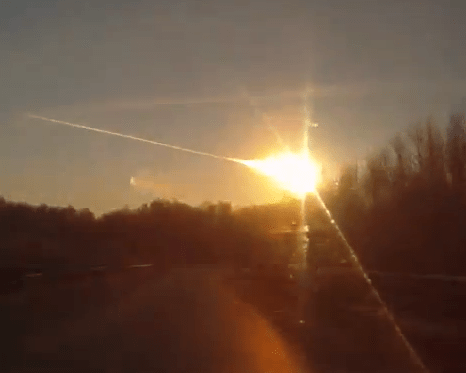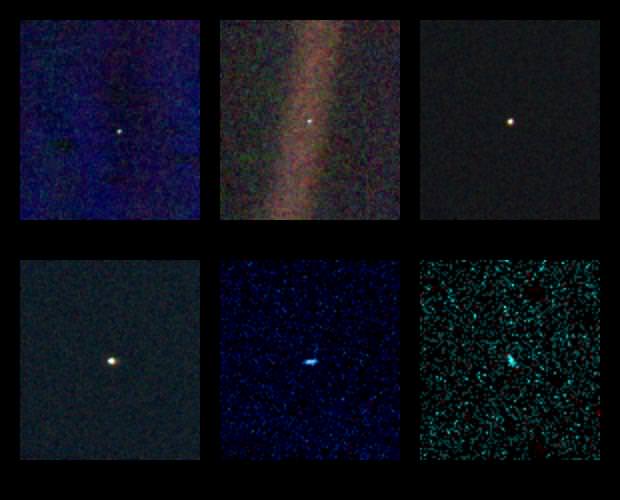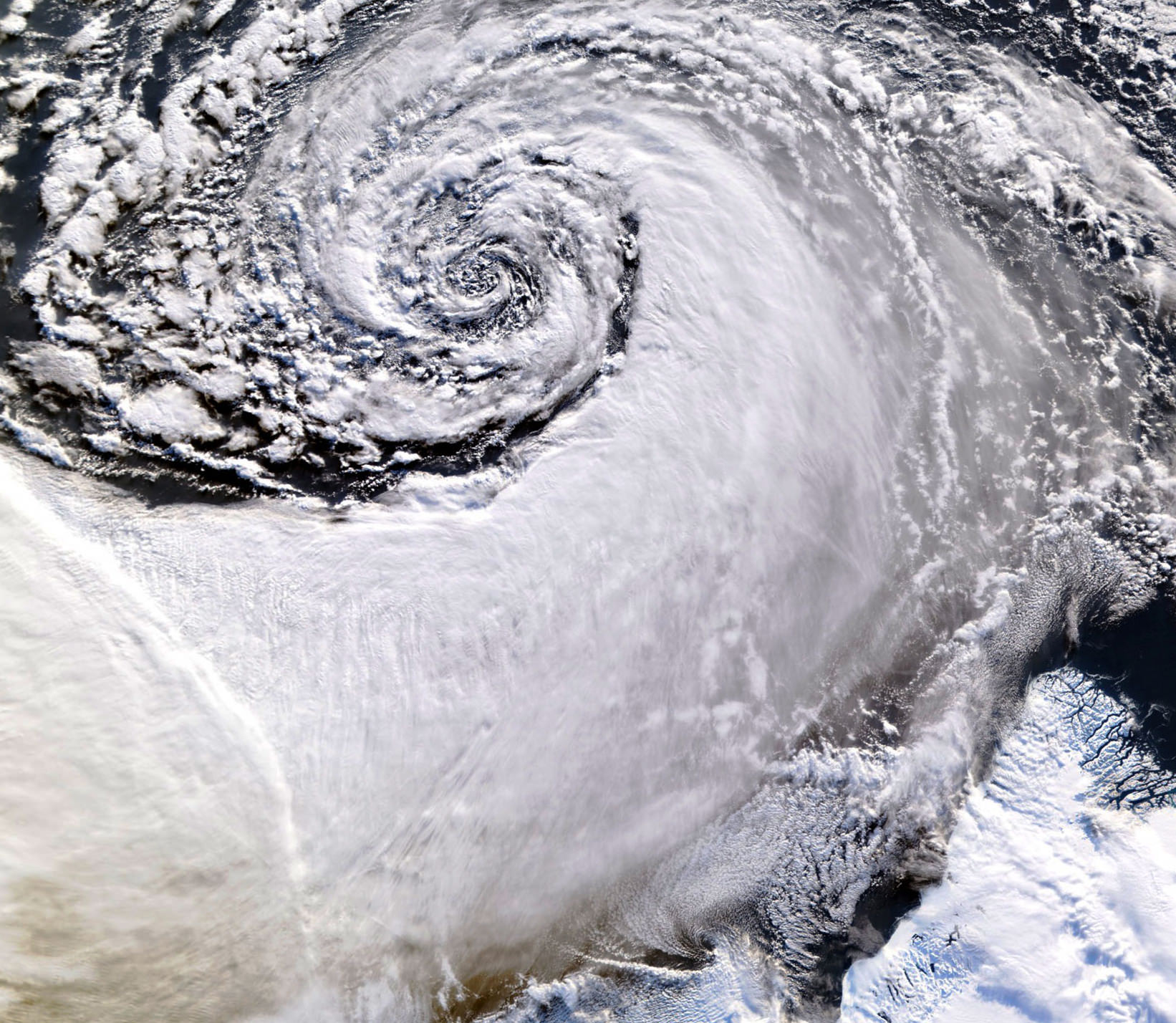Here’s the latest video of the fast approaching asteroid named 2012 DA14 that’s screeching towards our planet and set to give us all a very close shave this afternoon, shortly after 2 PM EST. NASA TV will provide Live coverage starting at 2 PM EST. Continue reading “Latest Video of Asteroid 2012 DA14 Steaking Towards Close Shave with Earth – as Meteor explodes over Russia”
Russian Meteor Not Related to Asteroid Flyby, NASA Confirms
The meteor that streaked over the skies of Russia — creating a shockwave that shattered windows, injuring upwards of 1,000 people — is not related to the asteroid that will whiz past Earth later today, (Feb.15), NASA has confirmed.
As many of our readers have noted in comments on our previous story on the Russian meteor, the trajectory of the Russian meteorite was significantly different than the trajectory of the asteroid 2012 DA14, making it a completely unrelated object.
“Information is still being collected about the Russian meteorite and analysis is preliminary at this point,” NASA said in a statement. “In videos of the meteor, it is seen to pass from left to right in front of the rising sun, which means it was traveling from north to south. Asteroid DA14’s trajectory is in the opposite direction, from south to north.”
Images and video of the Russian bolide taken from satellites in Earth orbit confirm the trajectory:
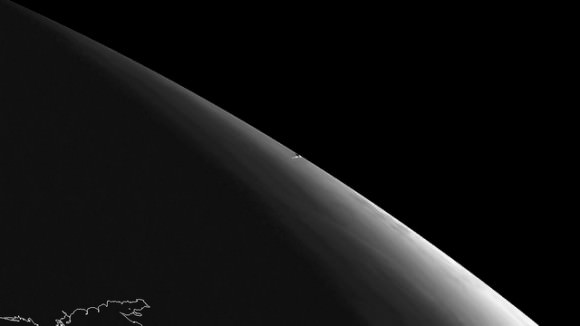
Reports are still coming in, but perhaps more than 1,000 people were injured, according to a statement from the Russian Emergency Ministry, primarily by glass cuts when windows were shattered from the shockwave blast. The vapor trail of the meteor was visible before the blast, so many people were standing in front of windows, looking at the trail visible across the sky.
The meteor appeared in the skies at around 09:25 a.m. local time in the Chelyabinsk region, near the southern Ural Mountains. It disintegrated and ‘exploded’ about 30-50 kilometers above Earth’s surface. The fireball blinded drivers and a subsequent explosion blew out windows. Reports of damaged buildings are being checked.
Initial estimates for the Russian Meteor are that it was a 1.5 meter-wide object weighing about 10 tons, traveling at 15 km/s.
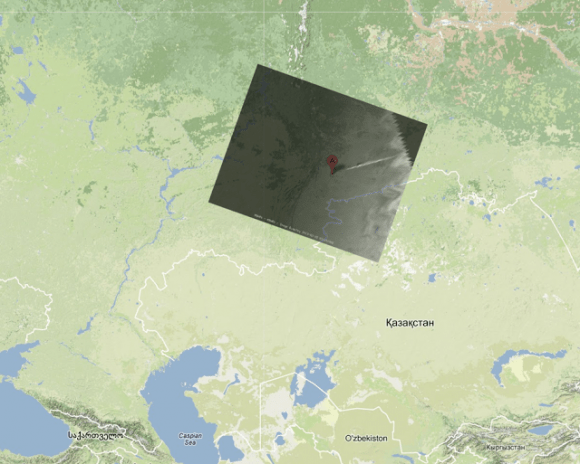
Nature News is reporting that this morning was the largest recorded object to strike the Earth in more than a century. “Infrasound data collected by a network designed to watch for nuclear weapons testing suggests that today’s blast released hundreds of kilotonnes of energy. That would make it far more powerful than the nuclear weapon tested by North Korea just days ago and the largest rock crashing on the planet since a meteor broke up over Siberia’s Tunguska river in 1908<" Nature News said.
[caption id="attachment_100015" align="aligncenter" width="580"]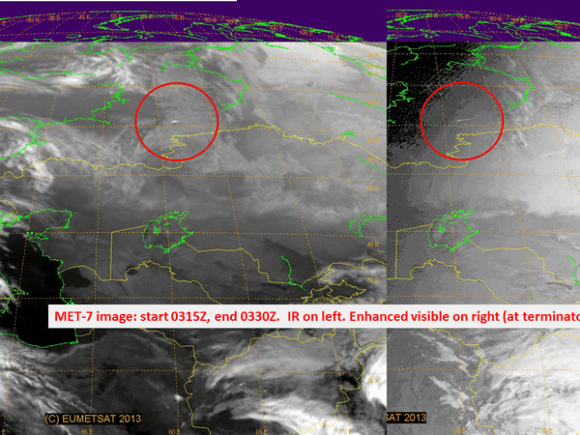 Satellite images from the European MET-7 weather satellite. Credit: EUMETSAT. [/caption]
Satellite images from the European MET-7 weather satellite. Credit: EUMETSAT. [/caption]
We’ll continue to provide updates on this story as they become available.
Meteor Blast Rocks Russia
This just in: reports of bright meteors and loud explosions have been coming from Russia, with the incredible video above showing what appears to be a meteor exploding in the atmosphere on the morning of Friday, Feb. 15.
According to Reuters the objects were seen in the skies over the Chelyabinsk and Sverdlovsk regions.
“Preliminary indications are that it was a meteorite rain,” an emergency official told RIA-Novosti. “We have information about a blast at 10,000-meter (32,800-foot) altitude. It is being verified.” UPDATE: The Russian Academy of Sciences has estimated that the single 10-ton meteor entered the atmosphere at around 54,000 kph (33,000 mph) and disintegrated 30-50 kilometers (18-32 miles) up. Nearly 500 people have been injured, most by broken glass — at least 3 in serious condition. (AP)
Chelyabinsk is 930 miles (1,500 km) east of Moscow, in Russia’s Ural Mountains.
Preliminary reports on RT.com state that the meteorite “crashed into a wall near a zinc factory, disrupting the city’s internet and mobile service.” 150 minor injuries have also been reported from broken glass and debris created by the explosion’s shockwave.
ADDED: More videos below:
Contrails and explosions can be heard here, with breaking glass:
Over a city commercial district:
And yet another dash cam:
Watch the garage door get blown in at the 30-second mark:
Here’s a great summary from Russia Today
This event occurs on the same day that Earth is to be passed at a distance of 27,000 km by the 45-meter-wide asteroid 2012 DA14. Coincidence? Most likely. But – more info as it comes!
Read what Phil Plait has to say about this on his Bad Astronomy blog here.
News source: Reuters. H/T to Matt Arnold.
Galactic Gas Cloud Could Help Spot Hidden Black Holes

The heart of our Milky Way galaxy is an exotic place. It’s swarming with gigantic stars, showered by lethal blasts of high-energy radiation and a veritable cul-de-sac for the most enigmatic stellar corpses known to science: black holes. And at the center of the whole mélange is the granddaddy of all the black holes in the galaxy — Sagittarius A*, a supermassive monster with 4 million times more mass than the Sun packed into an area smaller than the orbit of Mercury.
Sgr A* dominates the core of the Milky Way with its powerful gravity, trapping giant stars into breakneck orbits and actively feeding on anything that comes close enough. Recently astronomers have been watching the movement of a large cloud of gas that’s caught in the pull of Sgr A* — they’re eager to see what exactly will happen once the cloud (designated G2) enters the black hole’s dining room… it will, in essence, be the first time anyone watches a black hole eat.
But before the dinner bell rings — estimated to be sometime this September — the cloud still has to cover a lot of space. Some scientists are now suggesting that G2’s trip through the crowded galactic nucleus could highlight the locations of other smaller black holes in the area, revealing their hiding places as it passes.
In a new paper titled “G2 can Illuminate the Black Hole Population near the Galactic Center” researchers from Columbia University in New York City and the Harvard-Smithsonian Center for Astrophysics (CfA) in Cambridge, Massachusetts propose that G2, a cloud of cool ionized gas over three times more massive than Earth, will likely encounter both neutron stars and other black holes on its way around (and/or into) SMBH Sgr A*.
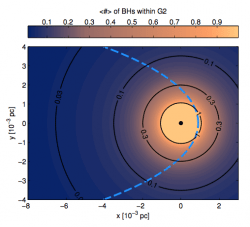
The team notes that there are estimated to be around 20,000 stellar-mass black holes and about as many neutron stars in the central parsec of the galaxy. (A parsec is equal to 3.26 light-years, or 30.9 trillion km. In astronomical scale it’s just over 3/4 the way to the nearest star from the Sun.) In addition there may also be an unknown number of intermediate-mass black holes lurking within the same area.
These ultra-dense stellar remains are drawn to the center region of the galaxy due to the effects of dynamical friction — drag, if you will — as they move through the interstellar material.
Of course, unless black holes are feeding and actively throwing out excess gobs of hot energy and matter due to their sloppy eating habits, they are very nearly impossible to find. But as G2 is observed moving along its elliptical path toward Sgr A*, it could very well encounter a small number of stellar- and intermediate-mass black holes and neutron stars. According to the research team, such interactions may be visible with X-ray spotting spacecraft like NASA’s Chandra and NuSTAR.
Read more: Chandra Stares Deep Into the Heart of Sagittarius A*
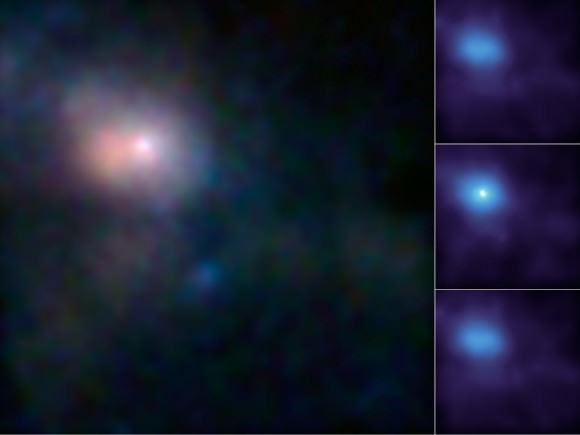
The chances of G2 encountering black holes and interacting with them in such a way as to produce bright enough x-ray flares that can be detected depends upon a lot of variables, like the angles of interaction, the relative velocities of the gas cloud and black holes, the resulting accretion rates of in-falling cloud matter, and the temperature of the accretion material. In addition, any observations must be made at the right time and for long enough a duration to capture an interaction (or possibly multiple interactions simultaneously) yet also be able to discern them from any background X-ray sources.
Still, according to the researchers such observations would be important as they could provide valuable information on galactic evolution, and shed further insight into the behavior of black holes.
Read the full report here, and watch an ESO news video about the anticipated behavior of the G2 gas cloud around the SMBH Sgr A* below:
This research was conducted by Imre Bartos, Zoltán Haiman, and Bence Kocsis of Columbia University and Szabolcs Márka of the Harvard-Smithsonian Center for Astrophysics.
Astronomers Provide a Peek at Asteroid 2012 DA14
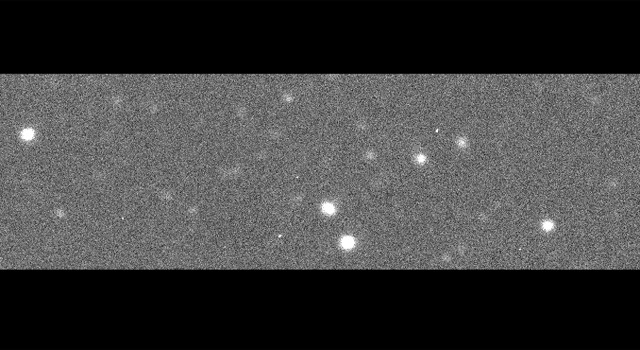
Our friends Ernesto Guido and Nick Howes from the Remanzacco Observatory — along with Edward Gomez from the Faulkes Telescope — have nabbed a look at asteroid 2012 DA14 as it was approaching Earth on Feb. 14, 2013 at around 11:06UT. Guido and Howes said the asteroid was about 748,000 kilometers (465,000 miles) from Earth, and was only about magnitude 17 in brightness. The animation was created from 3 images taken by Faulkes Telescope South through a 2.0-m f/10.0 Ritchey-Chretien telescope with a CCD. (You may have to click on the image for the animation, depending on your browser.)
See their website for some unique animations and detailed info about tomorrow’s (Feb. 15, 2013) close flyby of this 50 meter- (164 feet-) wide space rock.
Watch Live as Asteroid 2012 DA14 Whizzes Past Earth
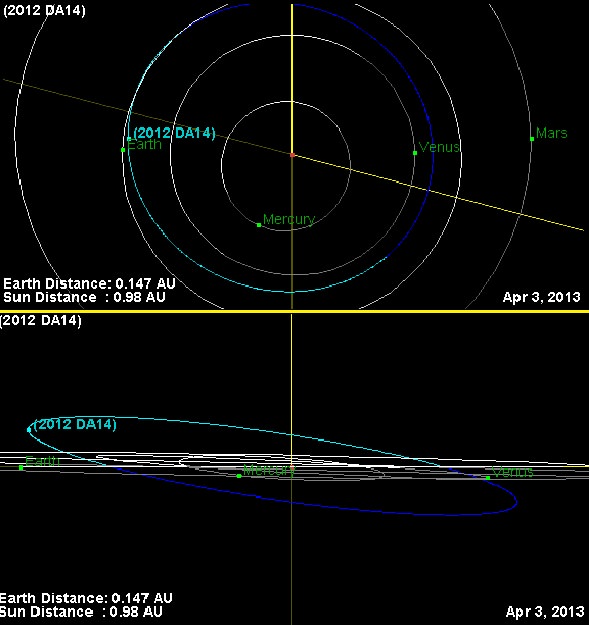
Want to keep tabs on asteroid 2012 DA14 as it whizzes past Earth tomorrow (Feb. 15)? NASA TV and several online astronomy outlets will be tracking this asteroid as it makes its record-setting close shave. This marks the first time there has been an asteroid of this size passing this close that we’ve known a year beforehand. No, there’s no chance it will hit us, but it will come within 27,630 kilometers (17,168 miles) from the surface of the Earth, inside the ring of geosynchronous satellites girdling our planet Earth. It will closest to Earth at 2:25 p.m. EST (19:25 UTC).
Find out how you can watch on TV or online as this 50 meter- (164 feet-) wide space rock goes by:
NASA Television will provide commentary starting at 2 p.m. EST (11 a.m. PST, 19:00 UTC) on Friday, Feb. 15. This flyby will provide a unique opportunity for researchers to study a near-Earth object up close. You can either watch the feed below, or on your own television if you get NASA TV, or online here.
Video streaming by Ustream
The half-hour broadcast from NASA’s Jet Propulsion Laboratory (JPL) in Pasadena, Calif., will incorporate real-time animation to show the location of the asteroid in relation to Earth, along with live or near real-time views of the asteroid from observatories in Australia, weather permitting.
Here are other webcasts that are planned:
Virtual Telescope Project, Italy
Astronomer Gianluca Masi from the Virtual Telescope Project will provide live views of asteroid 2012 DA14 from Ceccano, Italy, beginning at 5 p.m. EST (2200 GMT). You can watch at this link.
Bareket Observatory, Israel
The Bareket Observatory in Israel will have a free live webcast of the 2012 DA14 asteroid flyby on Friday from at 2 p.m. to 3:30 p.m. EST (19:00 to 20:39 UTC).
Here’s the link to this webcast.
“The observatory will offer a special live view of the close approach, using a remote telescope coupled with a cooled CCD camera, accessible via the Internet,” said the observatory team.
Slooh Space Camera, Africa and Arizona
The Slooh Space Camera webcast will provide views of the asteroid from observatories in the Canary Islands (off the west coast of Africa) and in Arizona. They will also be viewable on iOS and Android mobile devices. Just go to the Slooh website on your device.
Slooh’s webcast will begin on the 15th at 6 p.m. PST / 9 p.m. EST / 02:00 UTC (2/16). The webcasts will feature real-time commentary by Slooh Space Camera’s Paul Cox, astronomer Bob Berman of Astronomy Magazine, and Matt Francis, the manager of Prescott Observatory at Embry-Riddle University in Arizona.
Eye-Popping Interactive Panorama from the Curiosity Rover
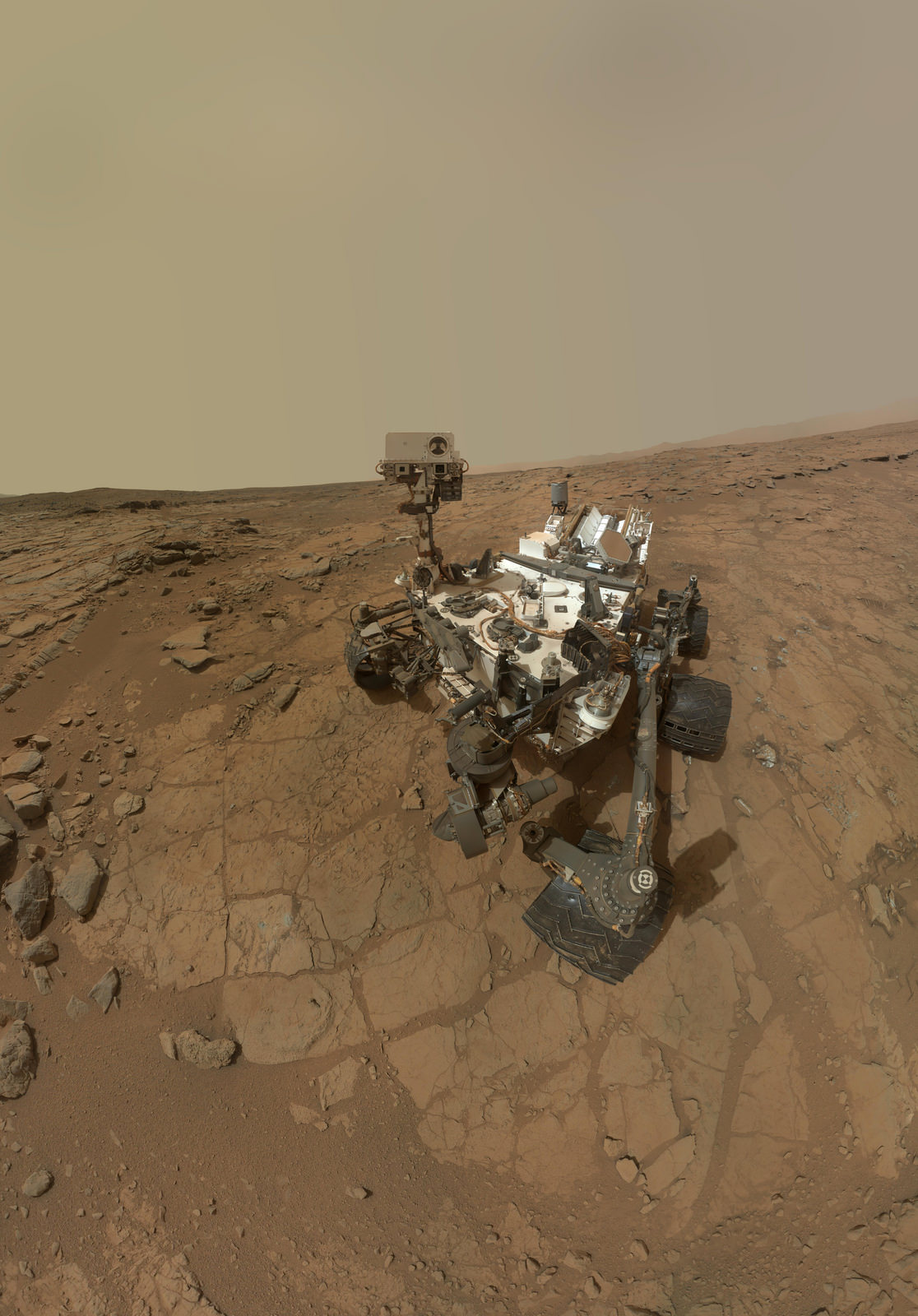
There’s an incredible new interactive panorama from the latest Curiosity rover’s self-portrait and surroundings at the “John Klein” drilling site. It was put together by photographer Andrew Bodrov and combines the recent self-portrait and other images to create a full 360-degree panorama created from hundreds of images. The mosaic stretches about 30,000 pixels width.
Click here to see (and go play with) the panorama.
The pan includes the self-portrait, which consists of 66 different images (seen above) taken by the rover’s Mars Hand Lens Imager (MAHLI) during the 177th Martian sol, of Curiosity’s work on Mars (Feb. 3, 2013 here on Earth), along with 113 images taken on Sol 170 and an additional 17 images taken on Sol 176.
Here’s the full pan in a non-interactive view:

In the pan, you can see the holes in the rock named John Klein — in memory of a Mars Science Laboratory deputy project manager who died in 2011. The historic first drilling took place on Feb. 8, 2013, and by zooming around and in, you can also see the weird little shiny protuberance we’ve been talking about (look for the pile of rocks to the right of the rover.)
Bodrov is a photographer from Estonia who specializes in interactive panoramic photography. He did a previous Curiosity pan in August 2012 and he’s also taken lots of images at the Baikonur Cosmodrome.
I’ve Always Dreamed of Being an Astronaut…
After seeing this on Google+, I knew I had to do a Bad Astronomer-like “want” post. This is a definite want. You can now be the first in your galaxy to have this awesome new bedding set. The duvet and pillow comes from a Dutch bedding shop named Snurk (that’s Dutch for ‘snoring’): “Underneath these sheets you will dream far beyond the stars…lie down, close your eyes and feel gravity decrease instantly.” They are now taking pre-orders, available in March.
Hat tip to Michael Interbartolo/Edward Burke
A Valentine From Voyager
On February 14, 1990, after nearly 13 years of travel through the outer Solar System, NASA’s Voyager 1 spacecraft crossed the orbit of Pluto and turned its camera around, capturing photos of the planets as seen from that vast distance. It was a family portrait taken from over 4.4 billion kilometers away — the ultimate space Valentine.
Who says astronomy isn’t romantic?

“That’s here. That’s home. That’s us. On it everyone you love, everyone you know, everyone you ever heard of, every human being who ever was, lived out their lives… There is perhaps no better demonstration of the folly of human conceits than this distant image of our tiny world.”
– Carl Sagan
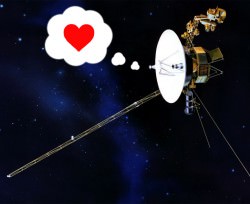 It was the unique perspective above provided by Voyager 1 that inspired Carl Sagan to first coin the phrase “Pale Blue Dot” in reference to our planet. And it’s true… from the edges of the solar system Earth is just a pale blue dot in a black sky, a bright speck just like all the other planets. It’s a sobering and somewhat chilling image of our world… but also inspiring, as the Voyager 1 and 2 spacecraft are now the farthest human-made objects in existence — and getting farther every second. They still faithfully transmit data back to us even now, over 35 years since their launches, from 18.5 and 15.2 billion kilometers away.
It was the unique perspective above provided by Voyager 1 that inspired Carl Sagan to first coin the phrase “Pale Blue Dot” in reference to our planet. And it’s true… from the edges of the solar system Earth is just a pale blue dot in a black sky, a bright speck just like all the other planets. It’s a sobering and somewhat chilling image of our world… but also inspiring, as the Voyager 1 and 2 spacecraft are now the farthest human-made objects in existence — and getting farther every second. They still faithfully transmit data back to us even now, over 35 years since their launches, from 18.5 and 15.2 billion kilometers away.
The Voyagers sure know the value of a long-term relationship.
An Enormous Arctic Spiral
Looking south across the southern tip of Greenland, this satellite image shows an enormous cloud vortex spiraling over the northern Atlantic ocean on January 26, 2013. An example of the powerful convection currents in the upper latitudes, these polar low cyclones are created when the motion of cold air is energized by the warmer ocean water beneath.
Sometimes referred to as Arctic cyclones, these spiraling storms can bring gale-force winds and heavy snowfall over a wide area of ocean during their 12- to 36-hour lifespans. Hurricane-type storms don’t only form in the tropics!
This image was captured by the MODIS instrument on NASA’s Aqua satellite from its polar orbit 705 km (438 miles) above the Earth. The view has been rotated so south is up; the southernmost tip of Greenland can be seen at lower right. Click for an impressive high-resolution view.
Image via EOSNAP/Chelys


